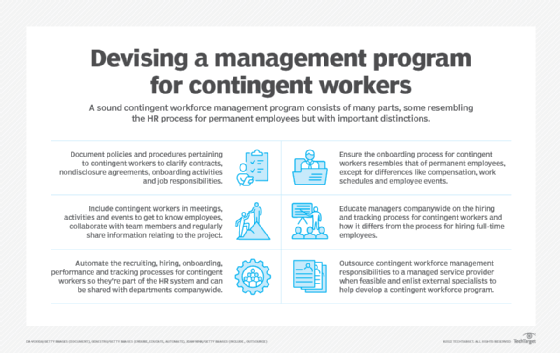6 best practices for managing a contingent workforce
A well-managed contingent workforce can provide welcome relief to businesses juggling their finances during trying times and a practical alternative to hiring permanent employees.
The combination of workers seeking to achieve a greater degree of flexibility and independence in their jobs and companies embracing the idea of finding people with the right skill sets whether or not they're employees has contributed to significant growth in contingent workforces during the past decade. Meantime, this shift from primarily hiring permanent employees to hiring contingent workers has presented businesses with new challenges in recruitment, performance tracking, and workforce integration and continuity.
What is a contingent workforce?
As opposed to company employees, a contingent workforce consists of temporary workers who may be independent contractors, consultants, freelancers or placed by an agency. These workers often have defined start and end dates and typically are paid on a project basis through a company's accounts payable rather than its payroll department. Additionally, the contingent workforce may have more flexibility about where and when they work instead of adhering to a standard 9-to-5 weekday schedule.
Companies benefit from using a contingent workforce because they can quickly ramp up when a project requires extra help and downsize when a project is completed, without the unpleasant task of employee layoffs. Contingent workers also may offer certain advanced skills that aren't available within the company's existing staff.
What is contingent workforce management?
Contingent workforce management is the sum of all the processes, policies, guidelines and activities required to incorporate contingent workers into the company. Attracting contingent workers, for example, is often different from the process for hiring employees. The typical hiring process includes posting open requisitions so candidates can apply, then identifying the best candidates to interview and ultimately hire. To recruit contingent workers, companies may use a third-party firm to help identify talent with the appropriate skill sets. Businesses may also hire contingent workers based on recommendations or their previous work with the company.
This article is part of
Ultimate guide to recruitment and talent acquisition

Many of the processes and policies developed to support employees and their experiences don't necessarily apply to contingent workers. But depending on the length and terms of the contract, contingent workers may be eligible for HR activities typically reserved for employees, including performance tracking and management, training and education, and inclusion in corporate events.
Contingent workforce management best practices
Managing a contingent workforce in these times can vary according to the industry, business operations and corporate culture and be influenced by events beyond a company's control. However, the following six best practices can serve as a guide when implementing and upgrading an effective contingent workforce management program.
- Define and document policies, guidelines and processes specific to contingent workers. Documentation clarifies the steps required when hiring contingent workers. This practice ensures that contracts and nondisclosure agreements are signed, onboarding activities are fulfilled, and manager and contingent worker expectations are clearly defined. To avoid blurring the lines between employees and contingent workers, for example, it may not be appropriate for contingent workers to participate in team events, unless the contract exceeds a certain number of months.
- Onboard contingent workers and permanent employees similarly but with some differences. Onboarding is an important step to ensure all new workers feel welcome and are productive on day one. When new hires join a company, they'll likely be required to complete employment forms, set up an email and network account, get an access badge, and so on. These activities may essentially be the same for employees and contingent workers -- with some differences. Employees are added to the payroll system, while contingent workers are compensated more like vendors by the finance department.
- Make contingent workers feel a part of the company and project team. The benefits received by employees are different compared to those of contingent workers. But it's important that contingent workers get to know members of the team, are situated in close proximity to the team if they're working on site and share information on a timely basis.
- Educate, train and communicate with managers about the hiring process for contingent workers. Hiring processes and policies need to be widely shared throughout the company, including the differences between hiring contingent workers and full-time employees. One key area is the process for tracking contingent workers. Since contingent workers don't necessarily impact a company's employee headcount, a hidden workforce can develop if a defined hiring and tracking process is not in place and enforced.
- Implement advanced technologies to automate contingent worker processes. Just like the processes for employees, systems designed to hire and track contingent workers should be automated. Determine if contingent workers will be added to the company's human resources information system, and if so, what information will have to be collected and transferred to certain departments within the company. The finance and IT departments, for example, must be notified when contingent workers join the company.
- Consider external resources to secure and manage contingent workers and specialized talent. Outsourcing contingent workforce management responsibilities to a managed service provider can help ensure efficient, compliant and effective processes. Alternatively, external specialists can help develop a company's contingent workforce management processes.
Practicing sound contingent workforce management
Contingent workforces continue to expand as people try to secure alternative work arrangements and companies increasingly fill open positions that don't require the long-term commitment of permanent workers. As a result, contingent workforce management takes on greater importance to determine the company's skills needs, develop a contingent worker recruitment, onboarding and tracking process, ensure overall workforce continuity and collaboration, and preserve corporate identity.








